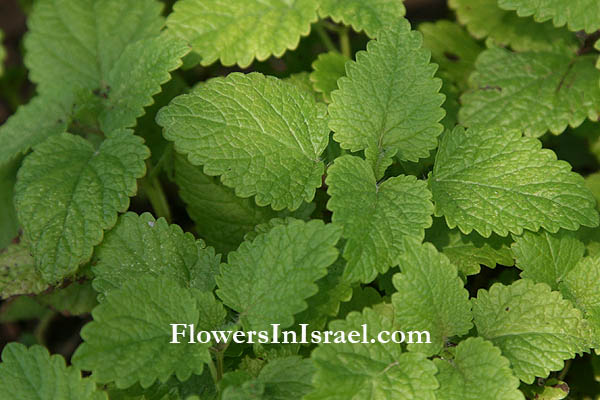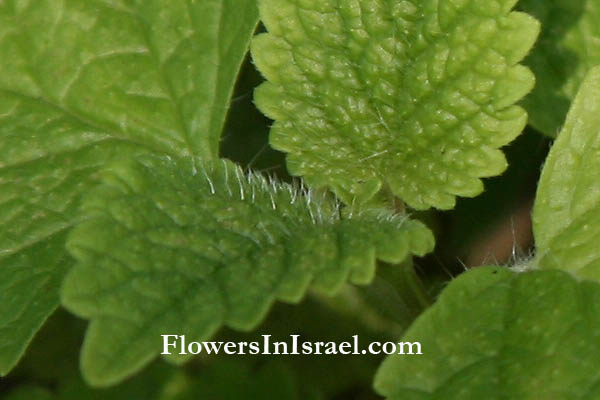Hebrew: מליסה רפואית, Arabic: ريحان الليمون
| Scientific name: | Melissa officinalis L. | |
| Common name: | Lemon Balm, Sweet Balm, Balm leaf | |
| Hebrew name: | מליסה רפואית | |
| Yiddish name: | Honik-melise, האָניק־מעליסע | |
| Arabic name: | ريحان الليمون "Raihan al-limun" | |
| Family: | Labiatae / Lamiaceae, שפתניים |

|
| Life form: | Hemicryptophyte | |
| Stems: | 40-80 cm high, erect, branched, shortly glandular-puberulent | |
| Leaves: | Opposite, entire, crenulate | |
| Inflorescence: | Verticillasters 4–12 flowered | |
| Flowers: | Calyx, campanulate, 2-lipped, 7–9 mm, tube ribbed, long-soft-hairy; corolla, 2-lipped, 8–15 mm, white, lilach | |
| Fruits / pods: | Nutlets 1.5-2mm, ovoid, smooth | |
| Flowering Period: | May, June, July, August, September | |
| Habitat: | Mediterranean maquis and forest, Batha, Phrygana, Humid habitats | |
| Distribution: | Mediterranean Woodlands and Shrublands, Montane vegetation of Mt. Hermon | |
| Chorotype: | Med - Irano-Turanian | |
| Summer shedding: | Perennating |

Derivation of the botanical name: Melissa, Greek, honey-bee; Melissa, the goddess as Queen-bee annually killed her male consort. officinalis, officina, herb pharmacy; alias, of or pertaining to; sold as an herb; medicinal. The hebrew name: מליסה, melissa, a transliteration from the scientific name.
He called Melissa officinalis "the elixer of life", and combined it with carbonate of potash in a mixture known as Primum Ens Melissae and is prepared in the following manner: "Take half a pound of pure carbonate of potash, and expose it to the air until it is dissolved (by attracting water from the atmosphere). Filter the fluid, and put as many fresh leaves of the plant melissa into it as it will hold, so that the fluid will cover the leaves. Let it stand in a well-closed glass in a moderately warm place for twenty-four hours. The fluid may then be removed from the leaves, and the latter thrown away. On the top of this fluid absolute alcohol is poured, so that it will cover the former to the height of one or two inches, and it is left to remain for one or two days, or until the alcohol becomes of an intensely green colour. This alcohol is then to be taken away and preserved, and fresh alcohol is put upon the alkaline fluid, and the operation is repeated until all the colouring matter is absorbed by the alcohol. This alcoholic fluid is now to be distilled, and the alcohol evaporated until it becomes of the thickness of a syrup, which is the Primum Ens Melissae; but the alcohol that has been distilled away and the liquid potash may be used again. The liquid potash must be of great concentration and the alcohol of great strength, else they would become mixed, and the experiment would not succeed." See the list of Medicinal herbs in Israel, the parts used and their medical uses to treat various diseases. |